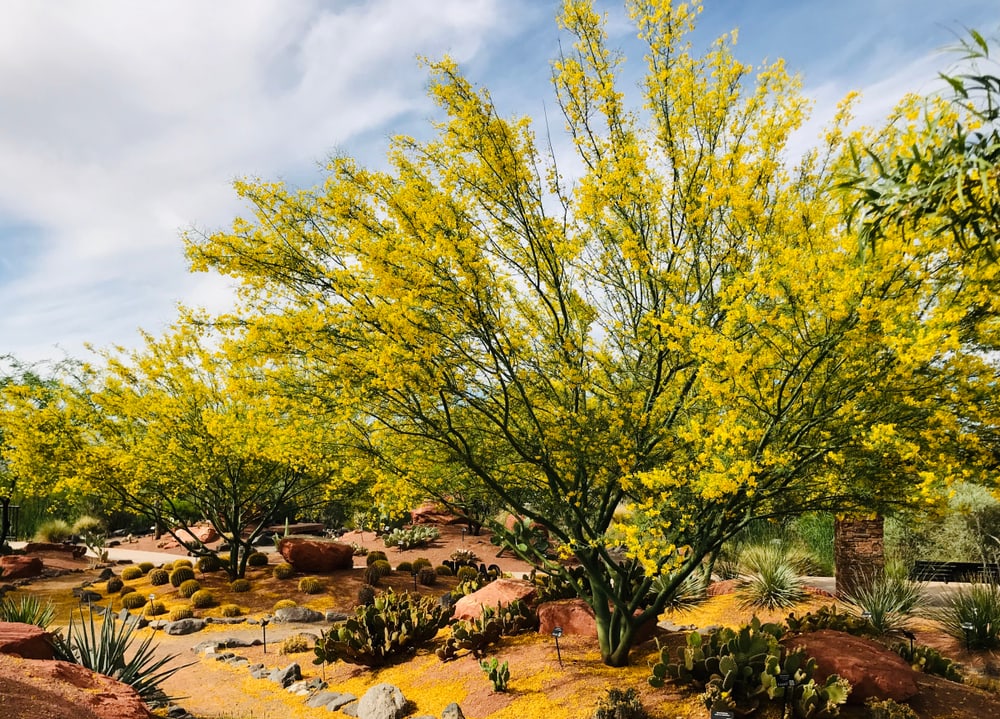What Is the State Tree of Arizona? Reasons, Range & Habitat
-
Chris Dinesen Rogers
- Last updated:

We’ve all heard of them—different symbols that states have adopted to showcase their heritage, achievements, or iconic elements. You’ll find items such as birds, foods, soils, and even dinosaurs. Of course, one of the grand ones of them all is the state tree. The choice was easy for Arizona. It became official in 1954 when the Grand Canyon State gave the Palo Verde its official designation.
You may wonder where this business of state symbols originated. You have to go back to the 1893 World’s Columbian Exposition held in Chicago to get the answer. The Congress of Representative Women discussed a proposal to create a National Garland of Flowers. While it didn’t happen then, it sowed the seeds for women’s clubs across the country to come up with their floral representatives.
State congresses gave their selections their official stamp of approval. Of course, it evolved into a wide variety of nominations. They were usually grassroots movements involving small groups or school children to create the necessary buzz. It’s a welcome break from more serious matters to contemplate simple things such as Delaware’s state dog, the Golden Retriever, or Maryland’s state cat, the Calico.
Description of the Palo Verde
The Palo Verde (Parkinsonia florida) is a deciduous tree with many traits of plants that live in similarly challenging environments. It isn’t a large species, reaching about 30 feet high. It has showy yellow flowers that attract its pollinators. The Palo Verde is also salt tolerant, a necessity for plants growing in these places.
Salts and minerals build up without the regular precipitation that would typically dissolve or wash them away. Over time, it creates a hardened layer of white caliche or the so-called hardpans.
The Spanish name for “Palo Verde” means “green stick,” which is a fitting description of this tree. It blooms in mid-spring, lasting until the end of May. It doesn’t have leaves most of the year, putting the spotlight on its green bark and, hence, its name. Photosynthesis or energy production occurs within its bark and branches instead of its leaves. They are only present for a short time, from late summer to fall.
Many desert plants have a similar ecological strategy. Photosynthesis requires a steady supply of moisture. Typically, the openings on the backside of a plant’s leaves open to allow for gas exchange. Cacti have needles instead of leaves for protection. Energy production happens elsewhere in these plants to conserve this precious resource. The leaves are tiny even when they are present.
Two varieties are native to Arizona, the Blue Palo Verde and the Foothill Palo Verde. The original legislation didn’t state which species it designated, so both have this status. The two look alike, with some variations. The former has droopy branches with a bushier growth form. It prefers valleys and washes since it grows faster.
The latter has a more upright form. Its height and leaves are smaller. It grows slower than the Blue Palo Verde, but it also lives longer. Both species are part of the Fabaceae or legume family. They produce pods with seeds like others in this group. However, you can eat the ones from the Foothill Palo Verde because they’re sweeter. The Cahuilla and other American Indian nations used them for food.

Range and Habitat
Like the Saguaro Cactus, the Palo Verde is unique because of its limited range, which it also shares with this plant. It lives in the American Southwest in Arizona, California, and Nevada. Its range stretches south into Mexico and Central and South America. The tree is native to the Sonoran Desert. As you may surmise, it is drought tolerant and can handle less than ideal soil conditions.
The Palo Verde lives in the forests and shrublands within its range, often occupying the valleys and washes where it can absorb moisture from runoff. While relatively long-lived, its numbers are stable. The International Union for Conservation of Nature and Natural Resources (IUCN) classifies it as a species of least concern.
The Reasons Arizona Chose This Species
As you can see, the Palo Verde has a long history in Arizona. That’s reason enough to consider it for the state tree. It’s an attractive species, too. You’ll see it in landscaping that takes advantage of its beauty. People also use it for erosion control to anchor soils in place. Remember that desert soils are often sandy with excellent drainage.
Arizona didn’t become a state until 1912, so the 1893 World’s Fair wasn’t the catalyst for the official naming. Instead, it was an example of a grassroots effort led by Mrs. Thode of Pinal County and 10 other women from six counties that brought the issue of a state tree to the forefront of the Twenty-first Legislature of Arizona in 1954.
The House of Representatives approved HB 227 on March 23, with the Senate following on April 3. It became official on April 9, 1954, when Governor John Howard Pyle signed it into law.
It’s worth noting that the original legislation had the genus name Cercidium. It was later revised to reflect the updated name given by scientists for this species.
Arizona takes the protection of its native plants seriously. Landowners must apply for a permit to salvage assessed native plants like the Palo Verde. The base penalty is $500 for violating the law, with points assigned to up the fine, depending on the circumstances of the offense.
Conclusion
It’s easy to see why the Arizona legislators elected to give the Palo Verde its official standing. It is a beautiful tree that is a quintessential part of the desert landscape. Thanks to the persistence of 11 women, the species has the protection that it deserves for residents and visitors to enjoy for many years to come.
Featured Image Credit: Kati Davis, Shutterstock
Contents
